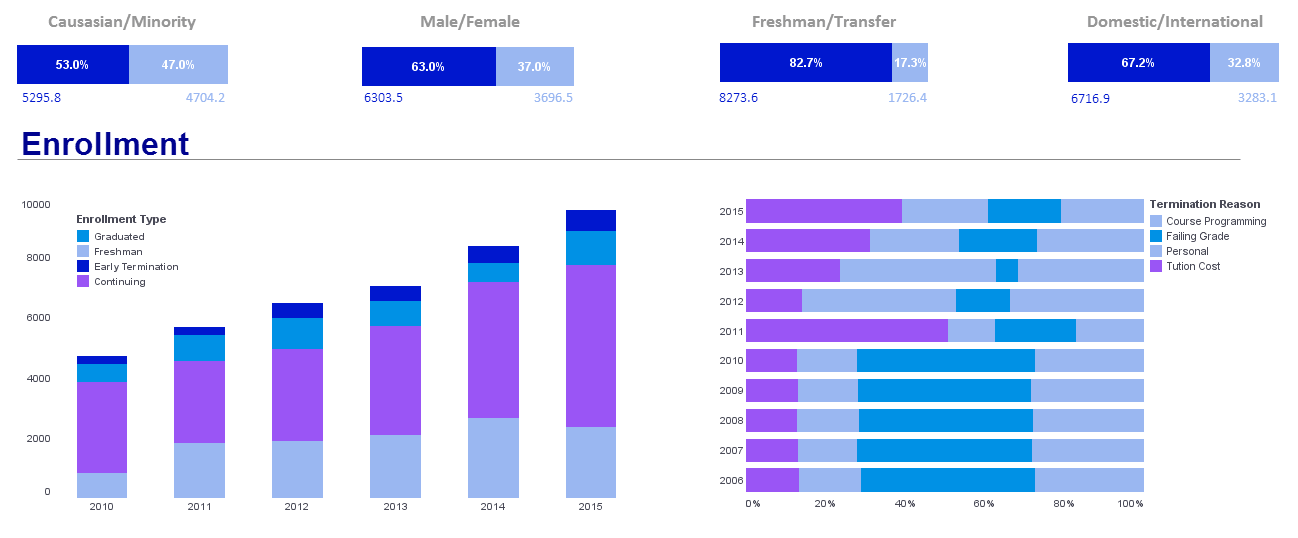Searching for an enterprise business intelligence solution?
As an innovator in BI software since 1996, InetSoft's award-winning application has been deployed at over 5,000 organizations around the world and integrated into dozens of other providers' solutions serving vertical and horizontal markets of their own. Read reasons why people chose InetSoft:
"Style Scope is a mature product with a good feature set," explains Jan Typp, CEO at Lean BI Tech. "In addition, the server-based license model was a great fit with our own license model."
"I needed to find a tool that could manage manipulating and combining data into a structure that I could then build a dashboard on," explains Susan DiBiccari, IT Consultant at Focus. "InetSoft's tool allowed me to do that with a simple drag and drop interface."
"InetSoft had the right combination of price, visualization capability, and interactivity to meet our needs," explains Mike Gindlesperger, Manager of Information and Technology Services at KDL. "Some of our more hands on customers are really going to enjoy InetSoft's ad hoc editing on interactive dashboards."
What Metrics Do Water Supply Enterprises Track with BI Solutions?
Water supply enterprises utilize Business Intelligence (BI) solutions to monitor and manage various aspects of their operations efficiently. The metrics tracked with BI solutions help in optimizing water distribution, ensuring compliance with regulations, and enhancing overall system performance. Here are some key metrics that water supply enterprises typically track:
- Water Quality Metrics:
- Water Purity Levels: Monitoring the concentration of contaminants and ensuring compliance with water quality standards.
- Chlorine Residual: Measuring the effectiveness of disinfection and ensuring water safety.
- Water Distribution Efficiency:
- Water Loss and Leakage Rates: Assessing the efficiency of the distribution system by tracking losses through leaks and unauthorized consumption.
- Distribution Network Pressure: Monitoring pressure levels to optimize water flow and minimize leakage risks.
- Supply and Demand Analysis:
- Water Consumption Trends: Analyzing historical consumption patterns to predict future demand.
- Peak Demand: Identifying periods of high water demand to optimize distribution strategies.
- Infrastructure Performance:
- Asset Utilization: Assessing the efficiency and performance of water infrastructure assets such as pumps, valves, and pipes.
- Maintenance and Repair Metrics: Tracking the frequency and effectiveness of maintenance activities.
- Customer Service Metrics:
- Response Time to Service Requests: Monitoring the time taken to address customer inquiries, complaints, and service requests.
- Customer Satisfaction: Gathering feedback and assessing satisfaction levels with water quality and service.
- Regulatory Compliance:
- Compliance with Water Quality Standards: Ensuring adherence to local, regional, and national water quality regulations.
- Reporting Compliance: Generating and submitting required reports to regulatory authorities.
- Financial Performance:
- Revenue Collection Efficiency: Monitoring the effectiveness of billing and revenue collection processes.
- Cost per Gallon: Calculating the cost of producing and distributing water per unit.
- Water Meter Analytics:
- Meter Accuracy and Reliability: Assessing the accuracy and reliability of water meters to ensure accurate billing.
- Meter Reading Efficiency: Tracking the efficiency of automated meter reading systems.
- Emergency Response Readiness:
- Contingency Planning Metrics: Evaluating the preparedness for emergency situations, such as droughts, floods, or contamination events.
- Response Time to Emergency Incidents: Measuring the time taken to address and resolve emergency situations.
- Water Conservation Metrics:
- Efficiency of Conservation Programs: Evaluating the effectiveness of water conservation initiatives.
- Public Outreach and Education: Monitoring the impact of educational campaigns on water conservation practices.
- Operational Efficiency:
- Energy Consumption: Tracking energy usage in water treatment and distribution processes.
- Operational Costs: Monitoring costs associated with staffing, equipment, and treatment processes.
- GIS Integration:
- Spatial Analysis: Utilizing Geographic Information System (GIS) data to analyze spatial patterns, identify vulnerable areas, and plan infrastructure improvements.
- Asset Mapping: Creating and maintaining accurate maps of water infrastructure for better decision-making.
- Water Source Management:
- Reservoir Levels: Monitoring water levels in reservoirs and assessing the availability of water sources.
- Source Sustainability: Evaluating the sustainability of water sources and planning for long-term resource management.
- Water Conservation Incentives:
- Effectiveness of Incentive Programs: Assessing the impact of incentive programs on water conservation behaviors.
- Participation Rates: Tracking the number of customers participating in water-saving initiatives.
- Weather Impact Analysis:
- Weather Conditions: Analyzing weather data to understand its impact on water demand, supply, and distribution.
- Climate Resilience Planning: Incorporating climate data into long-term planning for resilience against extreme weather events.
More Resources About Enterprise BI
Accurate Distribution Of Data - "In the realm of education, timely and accurate distribution of data is vital to improving student performance. By offering InetSoft's StyleBI, our clients can easily create meaningful views of the data, which are specific to their immediate reporting needs," said Shawn Bay, Founder and CEO of eScholar LLC. "Placing easy-to-use visual and analytical BI tools in the hands of our customers saves us time and money, while increasing customer satisfaction and brand loyalty...
Alternatives to Excel as a Datasource - If a business's Excel files are getting so big that it is becoming time consuming to add new rows and columns of data and they find they are navigating dozens of tabs and sheets, it is time to switch to simple databases...
Are We Embracing Complexity? - So it's just a matter of putting in the same format that they use like they did traditionally in a business that's changing or are they able to use it to put a new format to get different dimensions in different perspective? And finally, are we embracing complexity? And are we allowing ourselves to co-evolve with the system? And that's it...
Self-Service Harvest Dashboards - Visualization dashboards are the most intuitive way to understand project information. However, not all dashboards are created equal. InetSoft's web app can easily connect to Asana data to create self-service dashboards with rich built-in interactivity and customization...


